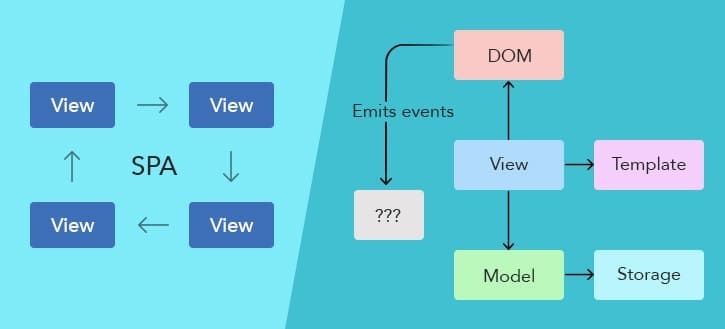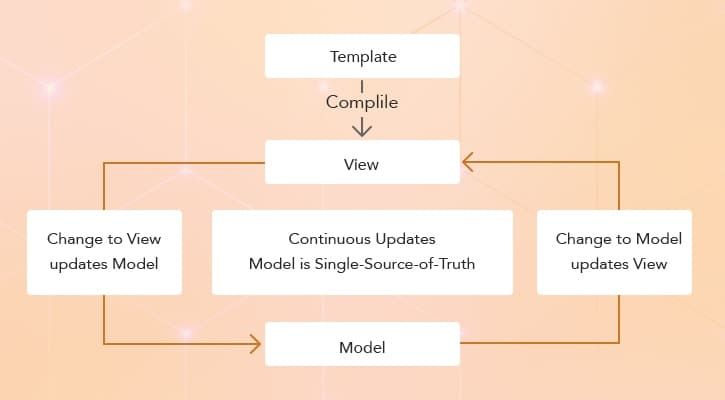Angular is a widely used framework in web application development, much like how HTML is essential for structuring websites. While HTML is effective for static content, it lacks flexibility when handling dynamic views. Angular extends HTML’s capabilities, making it easier for web app development that are interactive and scalable.
Instead of replacing HTML, CSS, or JavaScript, Angular enhances them, simplifying the development of rich web applications (RWAs). As a core part of the MEAN stack, it integrates with MongoDB, Express.js, and Node.js, offering an alternative to the LAMP stack (Linux, Apache, MySQL, PHP).
Core reasons behind Angular’s rise
Here are the key concepts and features of Angular that contribute to its growing popularity, especially among developers building modern, dynamic web applications.
Single Page Applications (SPA)
A single-page application (SPA) is very much similar to a web application running on a web browser, except the former interacts with the user by dynamically rewriting the single page rather than loading an entire new page from a server. This approach retains the core user experience between successive pages, making an SPA looks like a mobile application sandboxed inside a web browser.

In an SPA, all the HTML, JavaScript, and CSS elements are retrieved with a single page load. Communication with the single page application repeatedly comprises dynamic communication with the server behind the curtain.
AngularJS framework acclimates and outspreads traditional HTML to present dynamic content through bidirectional data-binding that enables automatic synchronization of models and views. Consequently, AngularJS depreciates plain DOM manipulation with the objective of improving testability and presentation.
Bidirectional data-binding
Data-binding is a programmed way of updating the view every time the model changes, on top of updating the model every time the view changes. That is, any change made in view will mirror in the model and vice a versa. The HTML template is, still, gathered in a web browser. The compilation step generates pure HTML, which the web browser re-renders to reflect on the view. The step is repeated for ensuing page views.

Unlike conventional server-side HTML programming wherein controller and model cooperate inside a server process to create fresh HTML views, Angular controller and model states are upheld within the client’s web browser. Consequently, created pages are capable of being created without the need of interacting with the server.
Rich Internet Applications (RIA)
The frontend development of rich internet applications is complicated with vanilla HTML and JavaScript owing to maintainability problems. The plain blend of HTML and JavaScript offers no likelihood to modularize and test the frontend in a clean manner.
AngularJ is an extension of HTML and adds dynamics to static HTML to enable development of maintainable rich internet applications by isolating static UI description and dynamic control logic as per the Model-View-Controller paradigm.
Model View Controller (MVC)
The Model View Controller segregates user interfaces into 3 parts: The model, which contains the data. The view, to which the data is presented to. The controller, which acts as a negotiator between user and model.
To permit communication among model, view and controller, AngularJS relies on Scopes. Scopes are Namespaces that are applied as plain JavaScript objects. An AngularJS app can have one root scope object and, evidently, many child scopes.
Read more: React vs Angular—Which is more popular JavaScript? Know Here
Model–View–ViewModel (MVVM)
Models talk to ViewModel objects via a root scope or child scope, which polls the Models for any changes, which is rendered by the Views, which is the HTML that displays your code. Views can be routed using the routeProvider object.
Evidently, AngularJS deep-links and organizes your Views and Controllers, turning them into navigable URLs and provides stateless controllers, which adjust and control the Scope object.
REST Easy
RESTful actions are quickly becoming the standard for communicating from the server to the client. In one line of JavaScript, you can quickly talk to the server and get the data you need to interact with your web pages.
AngularJ turns this into a simple JavaScript object, as Models, following the MVVM (Model View View-Model) pattern.
Dependency Injection (DI)
A developer just passes the dependency to the module and AngularJS takes care of everything and will inject them whenever the application needs.
To produce a controller, pass scope object and other dependencies to the module’s controller function. For instance, to produce a ProductController, we are passing scope object and Calculator service dependencies.

In Angular, dependencies can be passed in the following 3 ways. They are as follows:
- Function Arguments
- Array Arguments
- Inject service
Extends HTML
If you look behind the scene (Press Ctrl + U on your browser window), today’s websites are endless streams of < div > tags with little semantic lucidity. Unless you hire Angular developers, you may end up creating extensive and complex CSS classes manually to define each DOM object—costing time and efficiency. Angular operates HTML like XML, which gives web application developers endless possibilities for tags and attributes.
Angular achieves this, through its HTML compiler and the use of directives to prompt actions based on the newly-created syntax. In a nutshell, Angular Directives are features which boosts the functionality of html elements by integrating new functionalities to them.
Expressions are like code snippets bounded within curly braces, which don’t employ conditional statements or loops. They only format data to display.
Enterprise-level Testing
Aforementioned, Angular need no supplementary frameworks or plugins. That goes for testing too. If you're accustomed with projects: QUnit or Jasmine, then you'll have no anxiety learning Angular's unit-testing API and Scenario Runner, which directs you through performing quality analysis as close to the definite state of your production application as possible.
Read more: Testing Angular apps: A complete guide for developers
Google Engineers
Angular is built and maintained by dedicated (and brilliant) Google engineers. This means, you not only have a huge open-source community to learn from, but you also have accomplished, shrewd engineers tasked to get your Angular questions answered.
Popular Websites

The Guardian, Netflix, PayPal, Lego, Upwork, and The Weather Channel websites are built using Angular. Google shocked everybody when it announced that it has developed mobile app for Sony PlayStation using AngularJS.
Conclusion
Angular has undergone major advancements, introducing key improvements from v1.0 to v1.3 to enhance its capabilities. With the transition to Angular 2.0 and beyond, the framework continues to adapt to modern Angular development needs, ensuring compatibility with the latest browsers. This allows developers to focus more on building feature-rich applications rather than dealing with compatibility issues.
As businesses seek scalable and efficient web solutions, the demand to hire dedicated Angular developers is increasing. With its continuous advancements, Angular remains a strong choice for companies looking to develop dynamic and interactive web applications.









